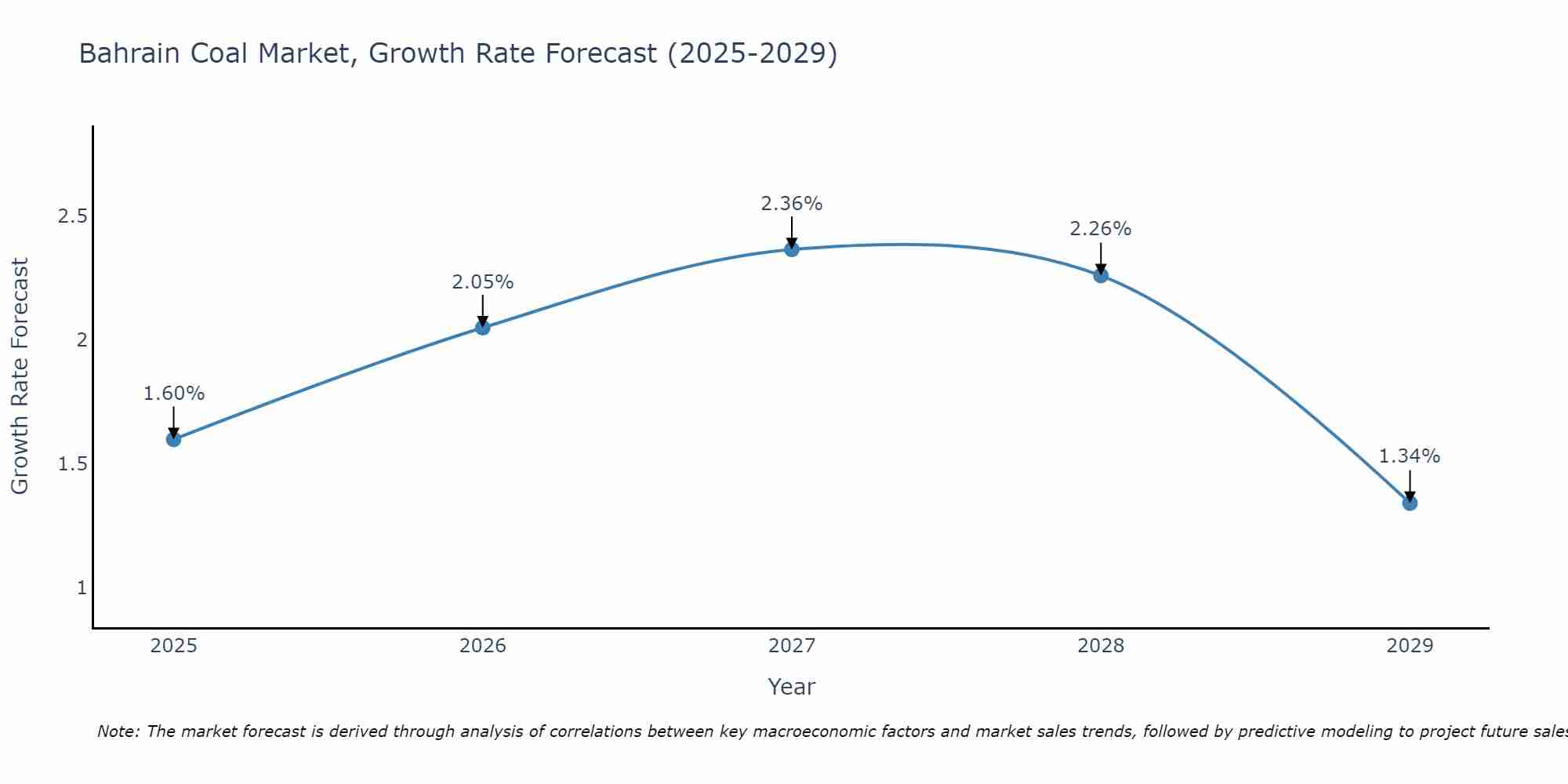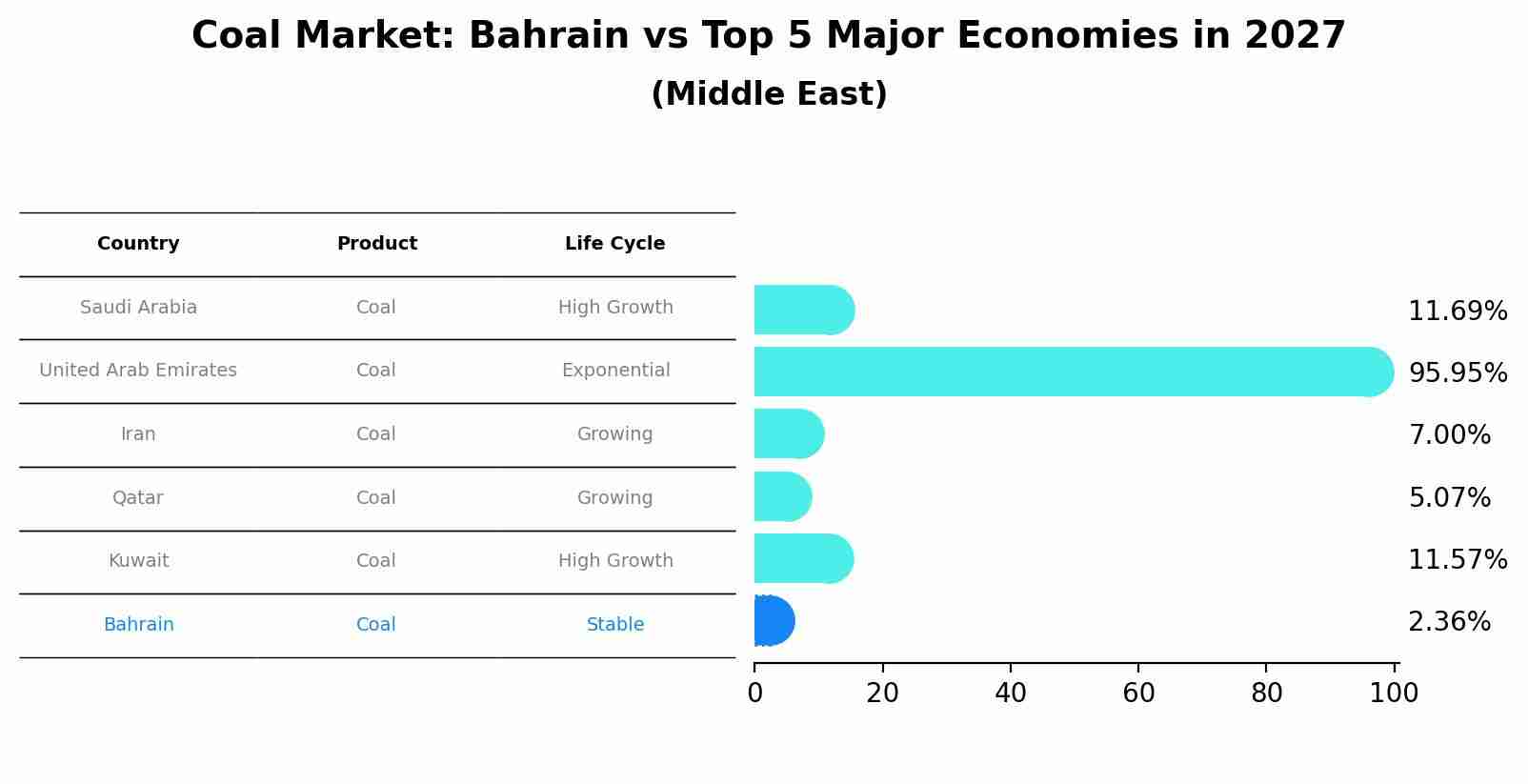Bahrain Coal Market (2025-2031) | Share, Revenue, Value, Companies, Analysis, Forecast, Size, Industry, Growth, Outlook & Trends
| Product Code: ETC038185 | Publication Date: Jan 2021 | Updated Date: Apr 2025 | Product Type: Report | |
| Publisher: 6Wresearch | Author: Ravi Bhandari | No. of Pages: 70 | No. of Figures: 35 | No. of Tables: 5 |
Bahrain Coal Market Size Growth Rate
The Bahrain Coal Market is projected to witness mixed growth rate patterns during 2025 to 2029. Starting at 1.60% in 2025, the market peaks at 2.36% in 2027, and settles at 1.34% by 2029.

Coal Market: Bahrain vs Top 5 Major Economies in 2027 (Middle East)
The Coal market in Bahrain is projected to grow at a stable growth rate of 2.36% by 2027, within the Middle East region led by Saudi Arabia, along with other countries like United Arab Emirates, Iran, Qatar and Kuwait, collectively shaping a dynamic and evolving market environment driven by innovation and increasing adoption of emerging technologies.

Bahrain Coal Market
The Bahrain coal market is experiencing steady demand driven by the use of coal in industrial processes such as power generation, steel production, cement manufacturing, and chemical processing. Coal is a fossil fuel that remains an important energy source globally, despite growing concerns about its environmental impact and carbon emissions. In Bahrain, coal is primarily imported to meet industrial and energy needs, as the country lacks significant domestic coal reserves. However, the government is exploring renewable energy alternatives and clean technologies to diversify the energy mix and reduce dependency on fossil fuels. With ongoing developments in energy policies and technologies, the Bahrain coal market is expected to evolve in line with global energy transitions.
Drivers of the market
The Bahrain Coal Market is experiencing significant growth driven by the increasing demand for energy and electricity, the rising consumption of coal in industrial and manufacturing processes, and the growing emphasis on energy security and diversification. Coal is a fossil fuel composed primarily of carbon and hydrocarbons, used for power generation, steel production, cement manufacturing, and other industrial applications. The expanding industrial sector, the rise of urbanization and infrastructure development, and the growing need for affordable and reliable energy sources in Bahrain are driving the demand for coal. Moreover, the benefits of energy independence, affordability, and availability associated with coal-fired power plants are further propelling market growth, enabling governments and utilities to meet the growing energy needs of industries and households effectively.
Challenges of the market
Challenges in the Bahrain Coal Market include the transition to cleaner energy sources, renewable alternatives, and sustainable fuels to reduce greenhouse gas emissions, mitigate climate change, and comply with international commitments to environmental protection and carbon neutrality. Additionally, concerns about coal mining regulations, coal-fired power generation, and coal consumption trends pose challenges for energy companies, policymakers, and stakeholders in Bahrain to diversify energy portfolios, invest in renewable energy infrastructure, and implement clean energy policies that support economic development, energy security, and environmental sustainability in the transition to a low-carbon future.
Government Policy of the market
Government regulations may govern energy production standards, mining regulations, and environmental requirements for coal extraction and utilization. Policies may include mining permits, environmental impact assessments, and emissions controls to ensure the sustainable and environmentally responsible development of coal resources in Bahrain.
Key Highlights of the Report:
- Bahrain Coal Market Outlook
- Market Size of Bahrain Coal Market, 2024
- Forecast of Bahrain Coal Market, 2031
- Historical Data and Forecast of Bahrain Coal Revenues & Volume for the Period 2021-2031
- Bahrain Coal Market Trend Evolution
- Bahrain Coal Market Drivers and Challenges
- Bahrain Coal Price Trends
- Bahrain Coal Porter's Five Forces
- Bahrain Coal Industry Life Cycle
- Historical Data and Forecast of Bahrain Coal Market Revenues & Volume By Types for the Period 2021-2031
- Historical Data and Forecast of Bahrain Coal Market Revenues & Volume By Bituminous Coal for the Period 2021-2031
- Historical Data and Forecast of Bahrain Coal Market Revenues & Volume By Sub-Bituminous Coal for the Period 2021-2031
- Historical Data and Forecast of Bahrain Coal Market Revenues & Volume By Anthracite for the Period 2021-2031
- Historical Data and Forecast of Bahrain Coal Market Revenues & Volume By Lignite for the Period 2021-2031
- Historical Data and Forecast of Bahrain Coal Market Revenues & Volume By End-Users for the Period 2021-2031
- Historical Data and Forecast of Bahrain Coal Market Revenues & Volume By Electricity for the Period 2021-2031
- Historical Data and Forecast of Bahrain Coal Market Revenues & Volume By Steel for the Period 2021-2031
- Historical Data and Forecast of Bahrain Coal Market Revenues & Volume By Cement for the Period 2021-2031
- Historical Data and Forecast of Bahrain Coal Market Revenues & Volume By Others for the Period 2021-2031
- Bahrain Coal Import Export Trade Statistics
- Market Opportunity Assessment By Types
- Market Opportunity Assessment By End-Users
- Bahrain Coal Top Companies Market Share
- Bahrain Coal Competitive Benchmarking By Technical and Operational Parameters
- Bahrain Coal Company Profiles
- Bahrain Coal Key Strategic Recommendations
Frequently Asked Questions About the Market Study (FAQs):
1 Executive Summary |
2 Introduction |
2.1 Key Highlights of the Report |
2.2 Report Description |
2.3 Market Scope & Segmentation |
2.4 Research Methodology |
2.5 Assumptions |
3 Bahrain Coal Market Overview |
3.1 Bahrain Country Macro Economic Indicators |
3.2 Bahrain Coal Market Revenues & Volume, 2021 & 2031F |
3.3 Bahrain Coal Market - Industry Life Cycle |
3.4 Bahrain Coal Market - Porter's Five Forces |
3.5 Bahrain Coal Market Revenues & Volume Share, By Types, 2021 & 2031F |
3.6 Bahrain Coal Market Revenues & Volume Share, By End-Users, 2021 & 2031F |
4 Bahrain Coal Market Dynamics |
4.1 Impact Analysis |
4.2 Market Drivers |
4.3 Market Restraints |
5 Bahrain Coal Market Trends |
6 Bahrain Coal Market, By Types |
6.1 Bahrain Coal Market, By Types |
6.1.1 Overview and Analysis |
6.1.2 Bahrain Coal Market Revenues & Volume, By Types, 2021-2031F |
6.1.3 Bahrain Coal Market Revenues & Volume, By Bituminous Coal, 2021-2031F |
6.1.4 Bahrain Coal Market Revenues & Volume, By Sub-Bituminous Coal, 2021-2031F |
6.1.5 Bahrain Coal Market Revenues & Volume, By Anthracite, 2021-2031F |
6.1.6 Bahrain Coal Market Revenues & Volume, By Lignite, 2021-2031F |
6.2 Bahrain Coal Market, By End-Users |
6.2.1 Overview and Analysis |
6.2.2 Bahrain Coal Market Revenues & Volume, By Electricity, 2021-2031F |
6.2.3 Bahrain Coal Market Revenues & Volume, By Steel, 2021-2031F |
6.2.4 Bahrain Coal Market Revenues & Volume, By Cement, 2021-2031F |
6.2.5 Bahrain Coal Market Revenues & Volume, By Others, 2021-2031F |
7 Bahrain Coal Market Import-Export Trade Statistics |
7.1 Bahrain Coal Market Export to Major Countries |
7.2 Bahrain Coal Market Imports from Major Countries |
8 Bahrain Coal Market Key Performance Indicators |
9 Bahrain Coal Market - Opportunity Assessment |
9.1 Bahrain Coal Market Opportunity Assessment, By Types, 2021 & 2031F |
9.2 Bahrain Coal Market Opportunity Assessment, By End-Users, 2021 & 2031F |
10 Bahrain Coal Market - Competitive Landscape |
10.1 Bahrain Coal Market Revenue Share, By Companies, 2024 |
10.2 Bahrain Coal Market Competitive Benchmarking, By Operating and Technical Parameters |
11 Company Profiles |
12 Recommendations |
13 Disclaimer |
- Single User License$ 1,995
- Department License$ 2,400
- Site License$ 3,120
- Global License$ 3,795
Search
Related Reports
- ASEAN and Thailand Brain Health Supplements Market (2025-2031) | Strategy, Consumer Insights, Analysis, Investment Trends, Opportunities, Growth, Size, Share, Industry, Revenue, Segments, Value, Segmentation, Supply, Forecast, Restraints, Outlook, Competition, Drivers, Trends, Demand, Pricing Analysis, Competitive, Strategic Insights, Companies, Challenges
- ASEAN Bearings Market (2025-2031) | Strategy, Consumer Insights, Analysis, Investment Trends, Opportunities, Growth, Size, Share, Industry, Revenue, Segments, Value, Segmentation, Supply, Forecast, Restraints, Outlook, Competition, Drivers, Trends, Demand, Pricing Analysis, Competitive, Strategic Insights, Companies, Challenges
- Europe Flooring Market (2025-2031) | Outlook, Share, Industry, Trends, Forecast, Companies, Revenue, Size, Analysis, Growth & Value
- Saudi Arabia Manlift Market (2025-2031) | Outlook, Size, Growth, Trends, Companies, Industry, Revenue, Value, Share, Forecast & Analysis
- Uganda Excavator, Crane, and Wheel Loaders Market (2025-2031) | Strategy, Consumer Insights, Analysis, Investment Trends, Opportunities, Growth, Size, Share, Industry, Revenue, Segments, Value, Segmentation, Supply, Forecast, Restraints, Outlook, Competition, Drivers, Trends, Demand, Pricing Analysis, Competitive, Strategic Insights, Companies, Challenges
- Rwanda Excavator, Crane, and Wheel Loaders Market (2025-2031) | Strategy, Consumer Insights, Analysis, Investment Trends, Opportunities, Growth, Size, Share, Industry, Revenue, Segments, Value, Segmentation, Supply, Forecast, Restraints, Outlook, Competition, Drivers, Trends, Demand, Pricing Analysis, Competitive, Strategic Insights, Companies, Challenges
- Kenya Excavator, Crane, and Wheel Loaders Market (2025-2031) | Strategy, Consumer Insights, Analysis, Investment Trends, Opportunities, Growth, Size, Share, Industry, Revenue, Segments, Value, Segmentation, Supply, Forecast, Restraints, Outlook, Competition, Drivers, Trends, Demand, Pricing Analysis, Competitive, Strategic Insights, Companies, Challenges
- Angola Excavator, Crane, and Wheel Loaders Market (2025-2031) | Strategy, Consumer Insights, Analysis, Investment Trends, Opportunities, Growth, Size, Share, Industry, Revenue, Segments, Value, Segmentation, Supply, Forecast, Restraints, Outlook, Competition, Drivers, Trends, Demand, Pricing Analysis, Competitive, Strategic Insights, Companies, Challenges
- Israel Intelligent Transport System Market (2025-2031) | Strategy, Consumer Insights, Analysis, Investment Trends, Opportunities, Growth, Size, Share, Industry, Revenue, Segments, Value, Segmentation, Supply, Forecast, Restraints, Outlook, Competition, Drivers, Trends, Demand, Pricing Analysis, Competitive, Strategic Insights, Companies, Challenges
- Uganda Precast and Aggregate Market (2025-2031) | Strategy, Consumer Insights, Analysis, Investment Trends, Opportunities, Growth, Size, Share, Industry, Revenue, Segments, Value, Segmentation, Supply, Forecast, Restraints, Outlook, Competition, Drivers, Trends, Demand, Pricing Analysis, Competitive, Strategic Insights, Companies, Challenges
Industry Events and Analyst Meet
Our Clients
Whitepaper
- Middle East & Africa Commercial Security Market Click here to view more.
- Middle East & Africa Fire Safety Systems & Equipment Market Click here to view more.
- GCC Drone Market Click here to view more.
- Middle East Lighting Fixture Market Click here to view more.
- GCC Physical & Perimeter Security Market Click here to view more.
6WResearch In News
- Doha a strategic location for EV manufacturing hub: IPA Qatar
- Demand for luxury TVs surging in the GCC, says Samsung
- Empowering Growth: The Thriving Journey of Bangladesh’s Cable Industry
- Demand for luxury TVs surging in the GCC, says Samsung
- Video call with a traditional healer? Once unthinkable, it’s now common in South Africa
- Intelligent Buildings To Smooth GCC’s Path To Net Zero













